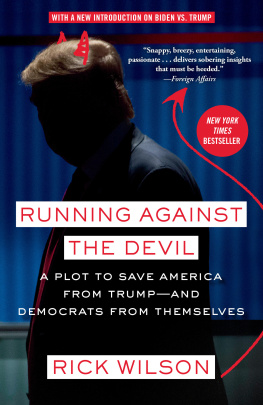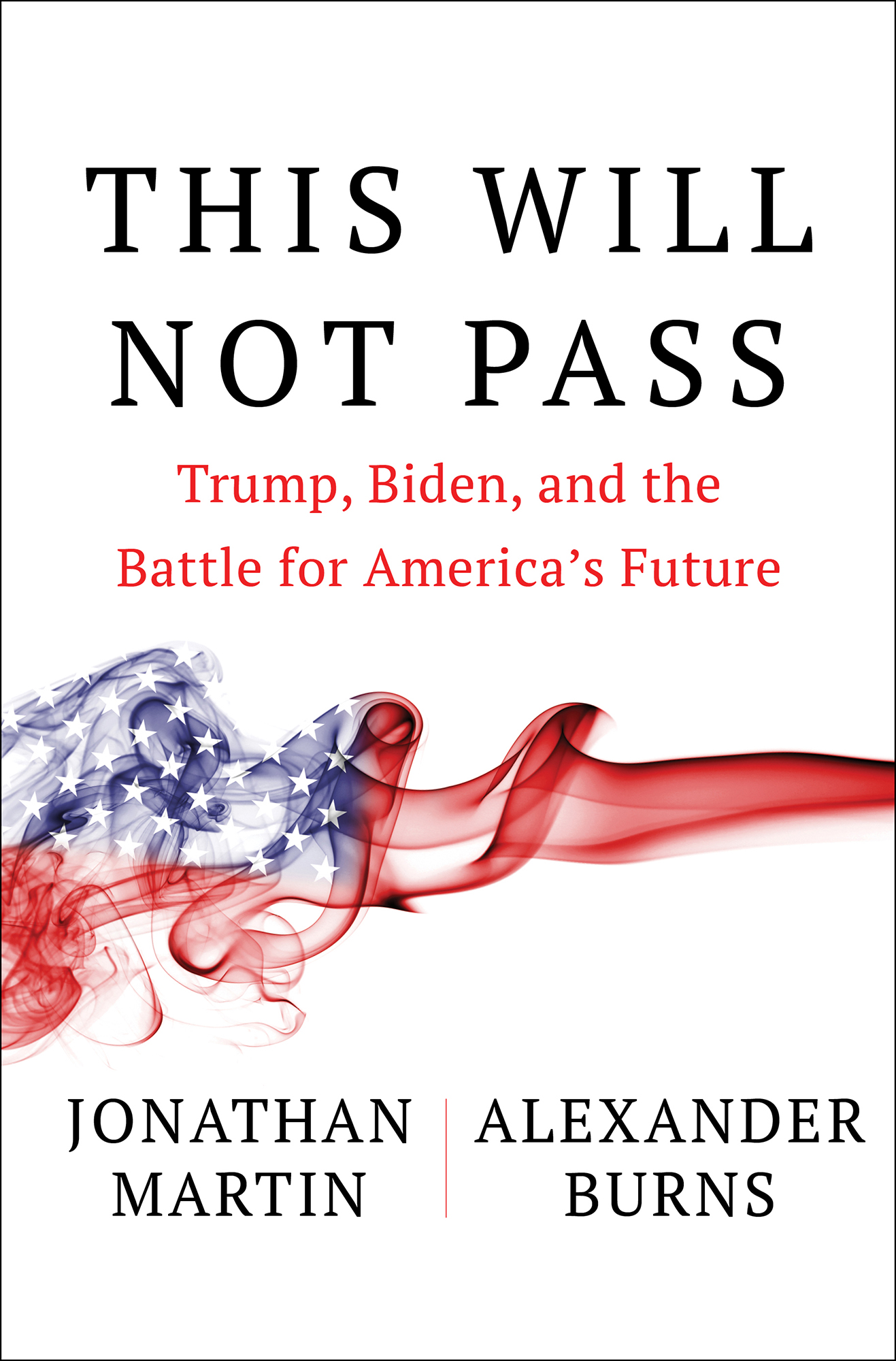Contents
Guide
This Will Not Pass
Trump, Biden, and the Battle for Americas Future
Jonathan Martin
Alexander Burns

Simon & Schuster
1230 Avenue of the Americas
New York, NY 10020
www.SimonandSchuster.com
Copyright 2022 by Jonathan Martin and Alexander Burns
All rights reserved, including the right to reproduce this book or portions thereof in any form whatsoever. For information, address Simon & Schuster Subsidiary Rights Department, 1230 Avenue of the Americas, New York, NY 10020.
First Simon & Schuster hardcover edition May 2022
SIMON & SCHUSTER and colophon are registered trademarks of Simon & Schuster, Inc.
For information about special discounts for bulk purchases, please contact Simon & Schuster Special Sales at 1-866-506-1949 or .
The Simon & Schuster Speakers Bureau can bring authors to your live event. For more information, or to book an event, contact the Simon & Schuster Speakers Bureau at 1-866-248-3049 or visit our website at www.simonspeakers.com.
Interior design by Wendy Blum
Jacket design by Eric Fuentecilla
Jacket art by Vladm/Shutterstock
Library of Congress Cataloging-in-Publication Data has been applied for.
ISBN 978-1-9821-7248-0
ISBN 978-1-9821-7250-3 (ebook)
For MJ and Penelope
A.I.B.
For Betsy and Ella
J.L.M.
A Note to Readers
T HIS BOOK IS based on hundreds of interviews with people at every level of government in Washington, scores of American states and cities, and several foreign capitals. These interviews were conducted on a range of terms: Some people agreed to speak on the record, meaning that they could be cited by name, while others insisted on some degree of anonymity in order to share the most sensitive elements of their experiences in this time of crisis.
Some sources relayed confidential documents to confirm or expand upon their recollections. Others shared audio or video tapes taken at crucial times, including recordings of private meetings with White House officials and congressional leaders. These materials represent a crucial contribution to the historical record, allowing the authors to narrate some of the most important and disturbing moments of this period in thorough detail.
Where quotations are attributed directly to individuals, using quotation marks, it is because they reflect the verbatim language used in interviews, text messages, emails, documents, or in recorded material, or were relayed by authoritative sources soon after the fact. In other situations, this book renders conversations and scenes in paraphrased form, without quotation marks.
Interviews for this book are quoted in the present tense to reflect that the speaker was looking back on events from a distance; conversations and remarks that unfolded in real time are quoted in the past tense.
In every instance, the authors have endeavored to tell the story of these tumultuous years in our history as vividly as possible, and with the highest degree of precision and fidelity to the facts.
Introduction A Recognizable Target
A BIGAIL S PANBERGER AND Alexandria Ocasio-Cortez were not close friends.
Though they both claimed House seats in 2018, an election year that elevated a vanguard of Democratic women, the two had little in common. Spanberger had been an operative with the Central Intelligence Agency before running for the House as a down-the-middle centrist in the red-tinted suburbs of Richmond, Virginia. Ocasio-Cortez, a decade her junior, was an organizer on the 2016 Bernie Sanders campaign and then defeated an incumbent member of the Democratic leadership, campaigning as a socialist in New York City.
In some respects, the two women represented the enormous gulf within the Democratic Party, separating the young left-wingers who made up the partys grass roots from the moderate suburban constituencies whose votes had delivered Democrats a majority in the House in 2018 and then elected Joe Biden to the presidency.
But in the first days of 2021, Spanberger and Ocasio-Cortez were not thinking much about their differences. Spanberger placed a call to her colleague on a more urgent subject.
In just a few days, Congress would be tasked with certifying the results of the 2020 election. In a normal year, it was a pro forma exercise. The popular vote had already been tallied and the Electoral College had carried out its arcane duties in the middle of December. The role of the House and Senate was mostly ornamental.
Things were shaping up differently this year. President Donald Trump had refused to concede the election, and he had instead spent the two previous months peddling increasingly outlandish conspiracy theories about election fraud. His complaints were ungrounded in fact, and lawsuits brought on his behalf had been all but laughed out of court.
But many of his followers had bought into Trumps claims, and a good number of them were planning to gather in Washington for a demonstration outside the Capitol on January 6. The president was clinging to a bogus theory that his obsequious vice president, Mike Pence, could use his status as the presiding officer in the Senate to block certification of the election.
As a former intelligence officer, Spanberger was concerned about the possibility of violenceparticularly violence targeting her fellow Democrats, and most especially the handful of highly recognizable progressive women who had been demonized by the right. She reached out to Ocasio-Cortez to urge her to take some unusual precautions, counseling an American lawmaker to approach the physical space of the Capitoland the ritual of certifying a free and fair electionwith the same caution she may have used with an intelligence asset in a dangerous foreign country.
You are a very recognizable target, Spanberger recalls telling Ocasio-Cortez. Drive to work, and make sure that you dress in a way where you are as less recognizable as you could possibly be.
Wear sneakers, dress downdont look like you.
That extraordinary conversation was one of many rippling through Congress in those tense days before January 6. In the aftermath of the insurrection, it would become clear that the national security apparatus of the United States and the police leaders responsible for defending the Capitol had failed to anticipate and prepare for the scale of the threat at hand. But to the lawmakers charged with completing the transfer of power between presidents, the mood of menace was pervasive.
To them, it was apparent enough that the basic institutions of American democracy had been strained almost to the breaking point.
In late December, Maxine Waters, the senior Democrat from Los Angeles, had spoken up on a video call with other lawmakers to inquire about security measures for January 6. Waters, one of the most recognizable Black women in Congress and a frequent target of the conservative media, was alarmed about one far-right organization in particular. In the first presidential debate, Trump had pointedly declined to denounce the extremist group known as the Proud BoysStand back and stand by, he told themand now some of its members appeared to be headed to Washington.
What, Waters asked, is being done about that?
On January 3, Democratic leaders issued guidance to lawmakers on keeping a low profile. Worried about a potential altercation with pro-Trump demonstrators on January 6, they advised the rank and file to conceal the special pins that identified them as members of Congress and to use a network of tunnels that runs under the Capitol to move around that day, rather than going outside. Lauren Underwood, a young lawmaker from Illinois, later paraphrased the safety advice with frustrated sarcasm: Itll be fine, but in case youre worried just take the tunnel.














